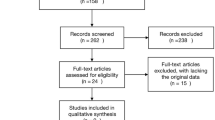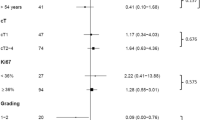Abstract
Objective
Neoadjuvant chemotherapy (NAC) was increasingly used as a systemic therapy for triple-negative breast cancer (TNBC). The pathological complete response (PCR) rates of neoadjuvant chemotherapy in TNBC were higher than other types of breast cancer with fluctuate data. Predictors to identify which subgroup TNBC was more likely to achieve PCR in neoadjuvant chemotherapy would give us some hints on how to improve outcomes of TNBC patients. The meta-analysis was conducted to contrast the prognostic function of some clinicopathological parameters in the PCR rates of neoadjuvant chemotherapy for TNBC.
Methods
Studies were selected from the PubMed database. The relevant parameters to PCR rates in TNBC group were recorded. Review Manager and MIX were used to estimate prognostic function of some biological markers and clinicopathological parameters in PCR rates of TNBC.
Results
The analysis included 6 studies with 723 patients, the aggregate PCR rate was 27.9% in TNBC group. The association of lymph nodes metastasis, Ki-67 expression, p53 expression and CK5/6 expression with PCR rate of TNBC was investigated in the analysis, and the odds ratios were 0.50, 9.87, 1.17 and 0.53 respectively.
Conclusion
This meta-analysis demonstrated that Ki-67 expression and lymph nodes metastasis were predictors of PCR rate for TNBC in neoadjuvant chemotherapy, while p53 and CK5/6 expression could not be confirmed for the prognostic function.
Similar content being viewed by others
References
Elias AD. Triple-negative breast cancer: a short review. Am J Clin Oncol, 2010, 33: 637–645.
Shi XB, Wang L. Treatment for triple-negative breast cancer. Chinese-German J Clin Oncol, 2012, 11: 539–543.
Yagata H, Kajiura Y, Yamauchi H. Current strategy for triple-negative breast cancer: appropriate combination of surgery, radiation, and chemotherapy. Breast Cancer, 2011, 18: 165–173.
Yagata H, Kajiura Y, Yamauchi H, et al. Current strategy for triplenegative breast cancer: appropriate combination of surgery, radiation, and chemotherapy. Breast Cancer, 2011, 18: 165–173.
Liedtke C, Mazouni C, Hess KR, et al. Response to neoadjuvant therapy and long-term survival in patients with triple-negative breast cancer. J Clin Oncol, 2008, 26: 1275–1281.
Bernsdorf M, Ingvar C, Jörgensen L, et al. Effect of adding gefitinib to neoadjuvant chemotherapy in estrogen receptor negative early breast cancer in a randomized phase II trial. Breast Cancer Res Treat, 2011, 126: 463–470.
Iwata H, Sato N, Masuda N, et al. Docetaxel followed by fluorouracil/epirubicin/cyclophosphamide as neoadjuvant chemotherapy for patients with primary breast cancer. Jpn J Clin Oncol, 2011, 41: 867–875.
De Laurentiisa M, Cianniellob D, Caputob R, et al. Treatment of triple negative breast cancer (TNBC): current options and future perspectives. Cancer Treat Rev, 2010, 36: S80–S86.
Bryan BB, Schnitt SJ, Collins LC. Ductal carcinoma in situ with basallike phenotype:a possible precursor to invasive basal-like breast cancer. Mod Pathol, 2006, 19: 617–621.
Bidard FC, Matthieu MC, Chollet P, et al. p53 status and efficacy of primary anthracyclines/alkylating agent-based regimen according to breast cancer molecular classes. Ann Oncol, 2008, 19: 1261–1265.
Darb-Esfahani S, Loibl S, Müller BM, et al. Identification of biologybased breast cancer types with distinct predictive and prognostic features: role of steroid hormone and HER2 receptor expression in patients treated with neoadjuvant anthracycline/taxane-based chemotherapy. Breast Cancer Res, 2009, 11: R69.
Ono M, Tsuda H, Shimizu C, et al. Tumor-infiltrating lymphocytes are correlated with response to neoadjuvant chemotherapy in triple-negative breast cancer. Breast Cancer Res Treat, 2012, 132: 793–805.
Masuda H, Masuda N, Kodama Y, et al. Predictive factors for the effectiveness of neoadjuvant chemotherapy and prognosis in triplenegative breast cancer patients. Cancer Chemother Pharmacol, 2011, 67: 911–917.
Li XR, Liu M, Zhang YJ, et al. CK5/6, EGFR, Ki-67, cyclin D1, and nm23-H1 protein expressions as predictors of pathological complete response to neoadjuvant chemotherapy in triple-negative breast can-cer patients. Med Oncol, 2011, 28: S129–S134.
Keam B, Im SA, Lee KH, et al. Ki-67 can be used for further classification of triple negative breast cancer into two subtypes with different response and prognosis. Breast Cancer Res, 2011, 13: R22.
Colleoni M, Viale G, Zahrieh D, et al. Expression of ER, PgR, HER1, HER2, and response: a study of preoperative chemotherapy. Ann Oncol, 2008, 19: 465–472.
Guarneri V, Barbieri E, Piacentini F, et al. Predictive and prognostic role of p53 according to tumor phenotype in breast cancer patients treated with preoperative chemotherapy: a single-institution analysis. Int J Biol Markers, 2010, 25: 104–111.
Nakagawa M, Bando Y, Nagao T, et al. Expression of p53, Ki-67, Ecadherin, N-cadherin and TOP2A in triple-negative breast cancer. Anticancer Res, 2011, 31: 2389–2393.
Andre F, Pusztai L. Heterogeneity of breast cancer among patients and implications for patient selection for adjuvant chemotherapy. Pharm Res, 2006, 23: 1951–1958.
Rakha EA, Elsheikh SE, Aleskandarany MA, et al. Triple negative Breast cancer: distinguishing between basal and nonbasal subtypes. Clin Cancer Res, 2009, 15: 2301–2310.
Gluz O, Liedtke C, Gottschalk N, et al. Triple-negative breast cancer-current status and future directions. Ann Oncol, 2009, 20: 1913–1927.
Bonnefoi H, Diebold-Berger S, Therasse P, et al. Locally advanced/inflammatory breast cancers treated with intensive epirubicin-based neoadjuvant chemotherapy: are there molecular markers in the primary tumour that predict for 5-year clinical outcome? Ann Oncol, 2003, 14: 406–413.
Rocca A, Viale G, Gelber RD, et al. Pathologic complete remission rate after cisplatin-based primary chemotherapy in breast cancer: Correlation with p63 expression. Cancer Chemother Pharmacol, 2008, 61: 965–971.
Author information
Authors and Affiliations
Corresponding author
Additional information
Supported by a grant from the Science & Technology Supporting Foundation of Liaoning Province (No. 20102060).
Rights and permissions
About this article
Cite this article
Zhang, G., Xie, W., Xu, L. et al. Predictors of neoadjuvant chemotherapy for triple-negative breast cancer: a meta-analysis with 723 cases. Chin. -Ger. J. Clin. Oncol. 12, 15–19 (2013). https://doi.org/10.1007/s10330-012-1104-8
Received:
Revised:
Accepted:
Published:
Issue Date:
DOI: https://doi.org/10.1007/s10330-012-1104-8




